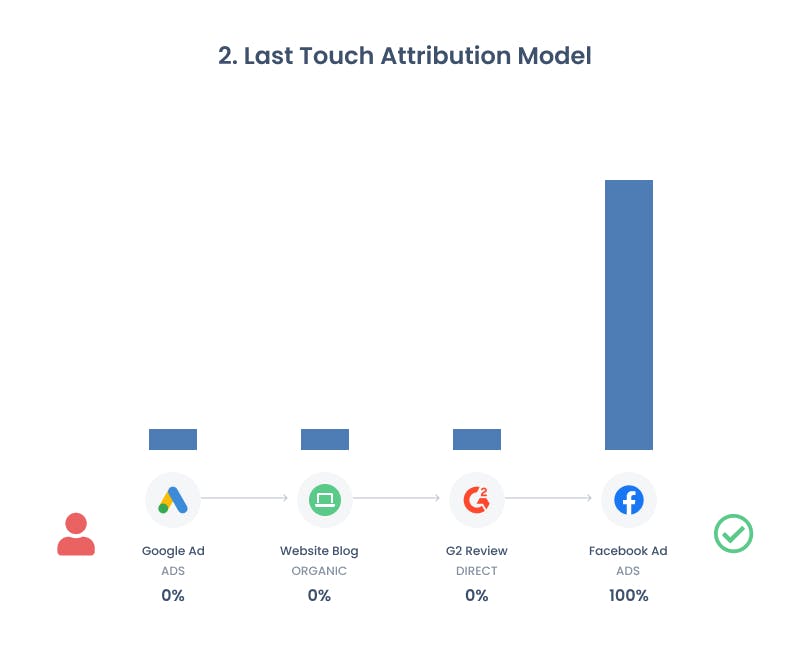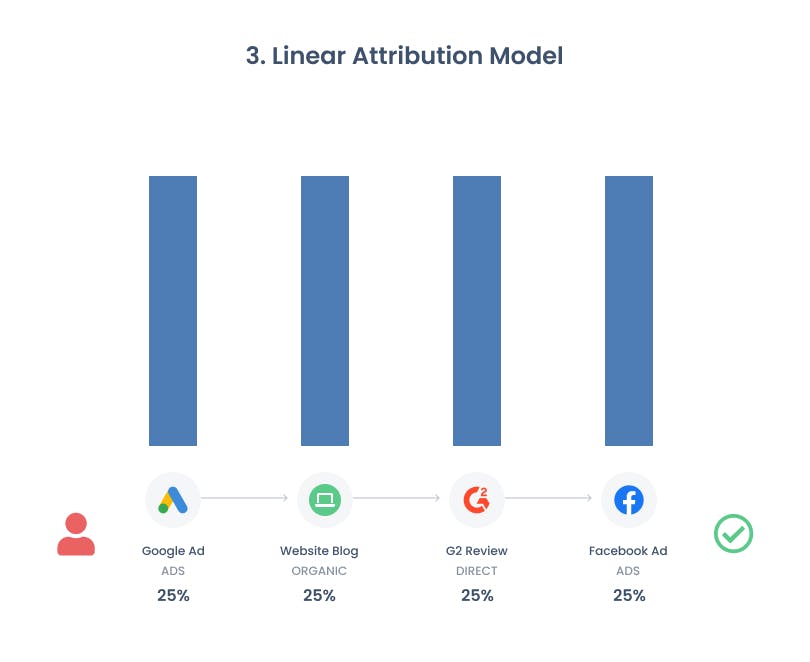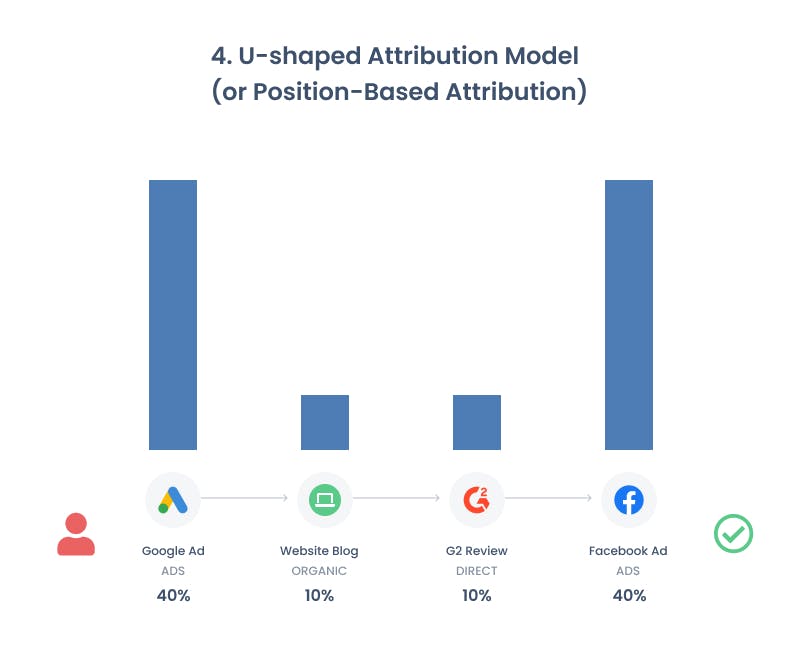Everything you need to know about marketing attribution modeling
Today’s average B2B customer journey is vastly different from what it was a decade ago. An ever-increasing number of channels and complex, siloed digital touch-points has made attributing marketing efforts to revenue a complicated endeavor. Several B2B marketing attribution software have popped up in recent years to solve this attribution challenge. But how can marketing attribution models help? Why are marketing attribution models necessary now more than ever? And which marketing attribution models should your marketing team be using?
Let’s find out.
What is marketing attribution?
Attribution in marketing is the process of identifying, tracking, and measuring the impact of customer interaction across various marketing efforts such as ad campaigns, website content, emails, etc. Marketing attribution assigns value or credits to these marketing touchpoints based on their contribution towards your conversion goal — whether that be demos scheduled, MQLs, revenue/pipeline etc.
Marketing attribution example: say your prospects clicked on a PPC ad (touchpoint 1) that leads them to a landing page on your website (touchpoint 2). This then prompts them to read one of your blogs (touchpoint 3) before initiating a free trial (touchpoint 4). The use of marketing attribution here helps understand the varying impact of these four touch points using data modeling. For example, with a U-shaped attribution model, credit may be assigned in the following manner: touchpoint 1 - 40%, touchpoint 2 - 10%, touchpoint 3 - 10%, and touchpoint 4 - 40%. This would imply that the prospects’ first and last interaction with your brand had the highest influence on their conversion.
What’s the difference between marketing attribution, revenue attribution, and digital marketing attribution?
When it comes to attribution, chances are you’ve come across a whole range of terms: marketing attribution, revenue attribution, digital attribution and so on. Well, be relieved to know that all these terms virtually mean the same things. They simply differ in terms of context:
Marketing attribution is more of a conceptual term that defines attribution as a marketing strategy in which you quantify the influence of your channels on customer conversion. Revenue attribution is identical in essence, but has a slightly different perspective. In revenue attribution, the focus is more on assigning value to channels to derive their revenue impact with the aim of optimizing marketing spend. Finally, the core principle of digital marketing attribution is that it is centered around attributing digital touchpoints, online prospects, etc.
Why is marketing attribution important (and useful)?
1. Marketing ROI Optimization: With marketing attribution, B2B teams achieve a better, wider picture of their channels’ cost-to-revenue ratio. By understanding every channels’ influence on lead conversion and pipeline in relation to their cost, one can effectively quantify marketing performance. Ultimately, this leads to our next point — smarter marketing investment and spend.
2. Improved Marketing Spends: Studies (and anecdotal evidence) suggests that the average B2B sales cycle can drag on for several months on end. This lengthy duration can affect businesses with flexible marketing budgets as it would be extremely unproductive to wait for sales teams to close deals to justify marketing spend. Now more than ever, marketing teams insist upon near-real-time optimization of campaign strategies.
Marketing attribution solves this issue by using lead metrics and your business’s unique channel acquisition mix to identify your MQLs and their forecasted revenue contribution early on. Setting lead metrics as conversion goals — such as leads generated — can estimate channel ROI before your lagging metrics. This data can be useful in setting up your PPC cost.
3. Attribution and Content Marketing: As is the current trend, B2B content marketing strategies play major roles in lead generation. Thus, understanding which types and pieces of content (blogs, webpages, podcasts, etc.) are driving conversions is key to informing the rest of your content strategy. Marketing attribution is inherently the perfect mechanism for this task. Learn more about measuring the ROI of B2B content here.
4. Mapping Out The Customer Journey: The use of attribution isn’t limited to understanding channel influence on conversion. It’s also a powerful tool to make sense of marketing’s influence across each step of the funnel. You can also use it to identify the relationship between channel interactions, which touchpoints work in conjunction with each other, and their relative probability of occurrence down the funnel. All of which help you map out your business’s unique customer journey.
What are marketing attribution models? How to measure marketing attribution?
We understand that marketing attribution is used to determine the impact of different touchpoints on conversions. But wouldn’t the credits assigned be arbitrary if we can’t figure out which touchpoints take precedence over the other? To solve for this, most marketers measure attribution using specific marketing attribution models. These are predetermined models that assign more or less credit to touchpoints based on the order of their occurrence down the funnel. Attribution that is governed by a set of preordained rules is known as rule-based attribution — the use of the attribution models falls under rule-based attribution. On the other hand, some marketers also utilize data-driven attribution (more on this later).
What are the different types of attribution models?
Single-touch marketing attribution models
Single-touch attribution, also known as single source attribution, assigns 100% of attribution credit to a single touchpoint (or a single source). While they’re easy to use and interpret, single-touch attribution models may skew your results and affect ROI if used in inappropriate situations. More on this under ‘How to choose the right marketing attribution model?’.
Consider the following example for all upcoming models: Similar to the previous example, let’s assume that a lead was in the market for a B2B SaaS tool and interacted with your brand 4 times.
- Touchpoint 1 - Prospect clicks on a PPC ad
- Touchpoint 2 - Prospect arrives at your site’s landing page
- Touchpoint 3 - Prospect subscribes to your newsletter
- Touchpoint 4 - A week later your prospect clicks on a newsletter campaign
- Touchpoint 5 - Prospect initiates a free trial before purchasing subscription
Touchpoints 1, 2, 3, 4, and 5 constitute all the prospect’s interactions with your brand that led to them purchasing your product. Keep in mind that in reality, businesses deal with numerous prospects interacting with several touchpoints, making the process of picking models convoluted.
The following are some of the most common single-touch marketing attribution models:
1. First-Touch Attribution: Also referred to as first-interaction or first-click attribution, this model assigns 100% of attribution credits to the first interaction your prospects had with your business. Considering the example, this model would assign 100% of sales credit to touchpoint 1. This means the PPC ad gets all the credit for the sale your business made.
2. Last-Touch Attribution: Also known as last-click attribution. As the name implies, this model assigns 100% of attribution credits to the last interaction your prospects made before making a purchase or converting to a lead. Using our example, this model would assign 100% of sales credit to touchpoint 5, meaning the free trial gets all the credit for the prospect’s purchase consideration.
3. Last Non-Direct Touch Attribution: This model assigns 100% attribution credit to the last non-direct touchpoint. A non-direct touchpoint is an interaction that is guided by a source the business sets up (like an ad, email campaign, etc.). When your website traffic doesn’t come from a known source, they are considered direct traffic (traffic that came from prospects directly entering the company URL into the browser for example). In our example, this model would assign 100% sales credit to touchpoint 4 or the newsletter campaign clicked on, as that was the last non-direct source before the sale. This model assumes that every interaction is a consequence of the non-direct campaign, hence making it the most influential.
Multi-touch attribution models
Multi-touch attribution is the most popular form of rule-based attribution, so much so that it is synonymous with the term marketing attribution. Multi-touch models consider all touchpoints when assigning credits rather than assigning them to a single source, providing a more holistic valuation across customer interactions.
The following are some of the most common multi-touch marketing attribution models:
1. Linear Attribution: This model equally distributes the same amount of attribution credits across all touchpoints the prospects interacted with. Using our example, this would mean that touchpoints 1, 2, 3, 4, and 5 all receive 20% of the sales credit each. This implies that all touchpoints played an equal role in converting the prospect to a customer.
2. Time Decay Attribution: In this model, attribution credits are incrementally distributed in ascending order. This model considers touchpoints closer to the sales transaction, or the latest touchpoints to be more influential than the earlier touchpoints. In our example, we can assume sales credit to be assigned this way:
- Touchpoint 1: 5%
- Touchpoint 2: 10%
- Touchpoint 3: 15%
- Touchpoint 4: 20%
- Touchpoint 5: 50%
(The percentage value assigned doesn’t have to be the same used in this example, but the principle stays the same)
3. Position-Based Attribution or U-Shaped Attribution: A U-shape model (a.k.a. position-based model) assumes that the first and last touchpoints have a bigger impact on conversion than the touchpoints between them. Hence taking the shape of the letter “U”. Typically, attribution tools assign equal credits between the first and last touchpoints, and the touchpoints in-between. In our example, it would look like this:
- Touchpoint 1: 35%
- Touchpoint 2: 10%
- Touchpoint 3: 10%
- Touchpoint 4: 10%
- Touchpoint 5: 35%
4. W-Shaped Attribution: This model, like the U-shaped model, considers the first and last touchpoints before conversion to be the most influential touchpoints along with something known as the middle funnel touchpoint. In a sales funnel the middle of the funnel is where qualified leads are generated. Thus, a W-shaped model assigns more credit to a lead-generating touchpoint in the middle. Using our example, a W-shaped attribution model would assign credits in this order:
- Touchpoint 1: 30%
- Touchpoint 2: 5%
- Touchpoint 3: 30%
- Touchpoint 4: 5%
- Touchpoint 5: 30%
Graphical examples of marketing attribution models:





Custom attribution models and data-driven attribution:
Custom attribution models: After testing and learning that none of the aforementioned models really suit your prospects unique buying pattern. You might want to consider creating a custom attribution model. A model that assigns credits in a suitable manner unique to your prospects and the channels your business uses. The difference between custom models and data-driven attribution is that custom models, like the previous models, are also rule-based.
Data-driven attribution: though similar to making a custom model, is used to assign credits dynamically using machine learning algorithms and customer trend analysis unique to the business. This is best suited for when you have prospect buying behavior that is constantly changing. Unlike rule-based models, data-driven attribution is fully dependent on data sets and large volumes to assign credits.
How to choose an appropriate attribution model?
When it comes to choosing which attribution model to use, there isn’t any specific rule of thumb. Businesses, brands, and products interact with their prospects in unique ways yielding different results. But, if there had to be one blanket recommendation, sales cycles are a good starting point. A business’s sales cycle more often than not has a direct relationship with the number of channels employed, their frequency, and complexity.
Businesses with shorter sales cycles that have prospects that either don’t interact with their brand too many times before conversion or have fewer channels to begin with, might prefer single-touch models. This is intuitive as the first interaction among a small array of touchpoints or the one before a sale is more likely to be very consequential in a purchase decision. Businesses that use obscure channels or specific search intent that is brand-oriented may also prefer single-touch marketing attribution models.
Businesses with longer sales cycles like in B2B marketing have a higher number of channels and frequency of touchpoints, making them a perfect use case for multi-touch attribution models. This is because multi-touch attribution accounts for all touchpoints. If you noticed, B2B marketing attribution though no short of multi-touch options, differentiates in funnel impact. For example, time-decay attribution prioritizes the bottom of the funnel, while a position-based model prioritizes only the top and the bottom. So, while you can’t single out a pivotal channel, you can credit influential ranges of channels across the funnel.
Single-touch attribution in longer sales might seem like a bad idea, but it depends on what your desired outcome is. First-touch attribution for example is a great model for identifying your customer acquisition channel and learning how your prospects interact with your brand early on. That being said, there is no right answer when it comes to choosing a model, especially when they’re all circumstantial use cases. Chances are, you’ll find yourself using more than one model or even different iterations of existing models, fine-tuning your approach more and more until you get what you’re looking for.
What to look for in a marketing attribution tool?
On paper, the concept of executing a marketing attribution solution might seem doable, but the practicality of building a functional tool is a tricky, expensive, and time-consuming ordeal. And if you’re someone who is interested or considering creating one, check out our build vs buy blog.
Picking the right marketing attribution tool can be a little complicated. There are several factors that distinguish a basic tool from a comprehensive and functional one. Here are some of those factors to look out for while choosing a marketing attribution tool:
- Can create custom models - Can Factors do this? Yes!
- Can compare different models - Can Factors do this? Yes, with our custom plans
- Has no shortage of filters and breakdowns - Can Factors do this? Yes!
- Can perform attribution with offline touchpoints - Can Factors do this? Yes!
- Has an abundance of integrations with other important tools and platforms - Can Factors do this? Yes!
- Has a robust reporting and dashboard facility - Can Factors do this? Yes!
- Can execute attribution at an account level - Can Factors do this? Yes!
- Satisfies all your privacy needs - Is Factors privacy compliant? Absolutely!
If you’re hunting for an off-the-shelf marketing attribution solution that facilitates all your attribution needs — including the ones listed above, look no further than Factors.ai. Book your personalized demo today!

